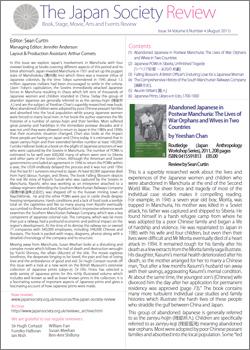Issue 34 (August 2011, Volume 6, Number 4)

In this issue we explore Japan’s involvement in Manchuria with four reviews looking at books covering different aspects of this period and its bitter aftermath. Japan invaded Manchuria in 1931 and set up the puppet state of Manshūkoku (満州国) into which there was a massive influx of Japanese colonists. By the time Tokyo surrendered in 1945 about 1.5 million Japanese civilians had been encouraged to settle in the colony. Upon Tokyo’s capitulation, the Soviets immediately attacked Japanese forces in Manchuria resulting in chaos which left tens of thousands of Japanese women and children stranded in China.
Today this group of abandon Japanese are generally referred to as the zanryu-hojin (残留邦 人) and are the subject of Yeeshan Chan’s superbly researched new book. Most abandoned children were adopted by poor Chinese peasant families and absorbed into the local population while young Japanese women were forced to marry local men. In her book the author examines the life histories of a number of zanryu-hojin and their families. Most suffered great poverty and hardships in the immediate postwar decades and it was not until they were allowed to return to Japan in the 1980s and 1990s that their economic situation changed. Chan also looks at the impact these people are having on Japan and China today. It is estimated that in Japan zanryu-hojin and their extended families number at least 100,000.
Fumiko Halloran looks at a book on the plight of Japanese prisoners of war who were captured by the Soviets in Manchuria. The number of POWs is estimated to be well over 600,000 many of whom were sent to Siberia and other parts of the Soviet Union. Although the American and Soviet governments concluded an agreement in 1946 to return the POWs within a year, the USSR endlessly delayed the process and it was not until 1956 that the last 811 survivors returned to Japan. At least 60,000 Japanese died from hard labour, hunger, and illness. The book Falling Blossom depicts the real life story of Kiyoshi Suzuki who was captured by the Soviets in Manchuria. Kiyoshi, who was working as an interpreter attached to a railway regiment defending the Southern Manchurian Railways Company (南満州鉄道株式会社), was shipped off to the Russian mining town of Raychikhinsk. He and the other POWs were put in cattle sheds despite freezing temperatures. Harsh conditions and a lack of food took a terrible total on the captivities and like so many young men Kiyoshi eventually succumbed to illness and died.
Kiyofumi Kato’s impressive reference work examines the Southern Manchurian Railways Company, which was a key component of Japanese colonial rule. The company, which was far more than just a railway, had a profound economic and political impact on the region’s development. At the time of its demise the railway ran or owned 71 companies with 340,000 employees, including 248,000 Chinese and Russians. The book is packed with maps, diagrams, photos along with a detailed chronology of the company and its structure.
Moving away from Manchuria, Susan Meehan looks at a disturbing and complex movie which follows the trail of death and destruction wrought by Yuichi Shimizu, the villain (Akunin) of the title. The movie explores loneliness, the desperate longing to be loved, the pain and fear of losing love and the ambivalence of good and evil.
Sir Hugh Cortazzi rounds off this issue with a look at a new work on the British Museum’s extensive collection of Japanese prints (ukiyo-e). Dr Ellis Tinios has selected a wide variety of Japanese prints for this richly illustrated volume which includes well known as well as lesser known prints in the collection. It is a fascinating survey of important aspects of Japanese prints and gives a fascinating account of how Japanese prints were made.
Contents
- Abandoned Japanese in Postwar Manchuria: The Lives of War Orphans and Wives in Two Countries
- Japanese POWs in Siberia, Unfinished Tragedy [シベリア抑留 ― 未完の 悲劇]
- Falling Blossom: A British Officer’s Enduring Love for a Japanese Woman
- The Comprehensive History of the South Manchurian Railways Company [満鉄全史]
- Akunin (Villain) [悪人]
- Japanese Prints, Ukiyo-e in Edo, 1700-1900
Contributors
Editor
Sean Curtin
Managing Editor
Jennifer Anderson
Layout & Production Assistant
Arthur Comets
Reviewers
Sean Curtin, Fumiko Halloran and Sir Hugh Cortazzi

